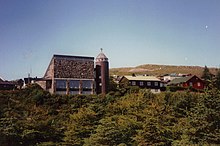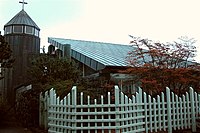Roman Catholic Church in the Faroe Islands

The Roman Catholic Church in the Faroe Islands goes back to the year 999 , disappeared with the Reformation in 1538 and has only existed continuously since 1931 until today within the immediate diocese of Copenhagen .
It has about 150 believers from 23 nations who live in the Faroe Islands. Your place of worship is the Church of St. Mary ( Mariukirkjan ) in Tórshavn, designed by the Faroese architect Arni Winther .
The Evangelical Lutheran state religion of the Faroe Islands, on the other hand, is represented by the Faroese People's Church .
prehistory
See main article: Christianization of the Faroe Islands
In the year 999 the Norwegian king Olav Tryggvason sent the Faroese Viking chief Sigmundur Brestisson together with several priests to the Faroe Islands to baptize the people and instruct them in the best of the Christian faith . The doctrine of the faith was then Roman Catholic .
In 1100 the Faroe Islands were elevated to the status of an independent diocese of the Faroe Islands , and in 1111 the first bishop took office in Kirkjubøur , which is now part of Tórshavn . For the next 400 years, 34 Catholic bishops resided in Kirkjubøur. The last bishop was Ámundur Ólavsson , who held office until 1538.
The 14th century Magnus Cathedral was dedicated to Saints Magnus and Þorlákur Þórhallsson ; the same patronage can be found on the Orkney Islands .
reformation
See main article: Reformation in the Faroe Islands
Christian III von Denmark had suspended the Norwegian Imperial Council in 1535 and incorporated Norway and the Faroe Islands into the Danish Kingdom. In 1537 the king decided to reform the church in Norway - and thus also in the Faroe Islands. During the Reformation, the old bishopric was abolished, the priestly school closed and all land in the Faroe Islands that was owned by the Catholic Church (around 40 percent) was confiscated in favor of the crown. The church language became Danish .
Bavarian interlude
After the introduction of religious freedom with the first Danish constitution in 1849, attempts were made to bring Catholicism back to the Faroe Islands. In 1857 the Bavarian clergyman Georg Bauer came to the islands. He built a church in Rættará in Tórshavn , but received little response. When he left the Faroe Islands in 1870, he had no successor and the church fell into disrepair.
Around 1900 there was only one Catholic woman left in the Faroe Islands, in Hvítanes . She had her own chapel there and was visited once a year by a priest from Copenhagen , who held mass for her.
The Franciscan Sisters
In 1931 two freshly trained priests, EG Boekenogen and Thomas King , were given the task of starting a Catholic community again. A small church was set up on May 23, 1931 in a house made available to the Franciscan Sisters Missionaries of Mary (FMM), who arrived in the Faroe Islands that year.
Among the first to find their way into the new church were some old citizens who went to church with Pastor Bauer as children. The small church in Bringsnagøta soon ran out of space. Therefore, on June 1, 1934, together with the St. Frans School , which the Franciscan Sisters had built, the Marienkirche was inaugurated.
The Franciscan Sisters were known in the Faroe Islands for the following things:
- They collected returnable bottles and put the proceeds into their St. Frans School, or they donated them to the hungry around the world.
- They also sold handicrafts for the same purpose.
- Occasionally they accepted students as foster children.
- They had Faroese teachers teach the Faroese language even though they themselves were foreigners from all over Europe.
- They learned Faroese themselves and spoke an accent that people called the "nun accent" that never went away.
- With their school they were always one step ahead of the rest of the school system. In comparison tests, their protégés were mostly the best.
- They taught the children in their school in the Evangelical Lutheran faith, although they were Catholics themselves.
- Their tolerant lifestyle made them a role model for many locals.
In 1985 the St. Frans School became part of the Tórshavn Commune when the Franciscan Sisters grew too old to continue running it. Today it has 350 students and 30 teachers. The characteristic red school building from 1934, designed by the Faroese architect HCW Tórgarð , is reminiscent of generations of Tórshavners who were trained here. In 1987 a new school building was inaugurated.
Marienkirche today

Today 's St. Mary 's Church was consecrated on August 30, 1987. This church is also the monastery church of the Franciscan Sisters. The congregation gathers here for mass every Sunday at 11 a.m.
All sorts of herbs grow in the garden around the church, many of which come from areas in the southern hemisphere, where growing conditions are similar to those in the Faroe Islands. They should symbolize that the Marienkirche is part of the Catholic world community.
See also
literature
- Ingi Rasmussen: "The teachers were versatile". In: Atlantic Review Autumn 2004, ( Atlantic Airways , Sørvágur 2004), pp. 5–8 (in-flight magazine of the Faroese airline)
- German: "The teachers wore a veil". In: News from the Faroe Islands 2/2005 ( Postverk Føroya ), pp. 2–5 (on the Internet )
Web links
- Katolsk.fo - Homepage (English, Danish and Faroese)
- Stamps.fo - Faroese Postal Administration (Public Domain, based on this article)
- Katholisch.de - "Small minority - big challenge" (interviews with Czeslaw Kozon, Bishop of Copenhagen and thus from all of Denmark, about the peculiarities of his diaspora church, Faroe Islands not specifically mentioned)


